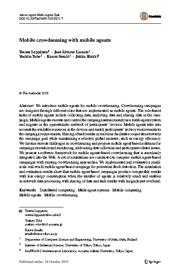Mobile crowdsensing with mobile agents
Teemu Leppänen, José Álvarez Lacasia, Yoshito Tobe, Kaoru Sezaki, Jukka Riekki
2015
Autonomous Agents and Multi-Agent Systems
We introduce mobile agents for mobile crowdsensing. Crowdsensing campaigns are designed through different roles that are implemented as mobile agents. The role-based tasks of mobile agents include collecting data, analyzing data and sharing data in the campaign. Mobile agents execute and control the campaign autonomously as a multi-agent system and migrate in the opportunistic network of participants' devices. Mobile agents take into account the available resources in the devices and match
more »
... cipants' privacy requirements to the campaign requirements. Sharing of task results in real-time facilitates cooperation towards the campaign goal while maintaining a selected global measure, such as energy efficiency. We discuss current challenges in crowdsensing and propose mobile agent based solutions for campaign execution and monitoring, addressing data collection and participant-related issues. We present a software framework for mobile agents-based crowdsensing that is seamlessly integrated into the Web. A set of simulations are conducted to compare mobile agent-based campaigns with existing crowdsensing approaches. We implemented and evaluated a smallscale real-world mobile agent based campaign for pedestrian flock detection. The simulation and evaluation results show that mobile agent based campaigns produce comparable results with less energy consumption when the number of agents is relatively small and enables in-network data processing with sharing of data and task results with insignificant overhead. With the introduction of smartphones into our everyday lives, new types of location-based and context-aware applications and services have emerged. Previously unobservable phenomena can be addressed by involving citizens in participatory sensing campaigns, where local knowledge of communities and special interest groups can be exploited at different scales for common good [4, 5, 26] . Crowdsensing applications create participatory sensor networks, where people take active roles with their personal mobile devices. Human intelligence and social interactions are leveraged to gather and analyze context-aware and semantically complex information and to share this knowledge of urban phenomena [5, 19, 31] . People and their situations are utilized to maximize the data quality, coordinate crowdsensing campaigns and delivering personalized services [5, 13, 26] . Sensor network deployments no longer require fixed infrastructure, but physical proximity is required. Human mobility patterns, everyday actions and willingness to participate opportunistically extends the data collection and sensing coverage with possibly large numbers of devices [1, 4, 5, 18, 26, 36] . The unprecedented variety and scale of crowdsensing applications introduce challenges for systems design and development. Location-based and multimodal real-world data needs to be incorporated into campaigns and integrated with social networking services and existing systems to increase data utility [8, 19, 31, 38] . Campaigns can't be designed without the consideration of human-oriented aspects, such as how participants interact with the application and the environment. In active (i.e. participatory) sensing, participants actively opt-in to campaigns and perform required actions, whereas in passive (i.e. opportunistic) sensing, the applications decide who meets the requirements and data is collected automatically [20, 30] . Applications can be categorized into: (1) personal, involving data that the participant considers sensitive; (2) social, involving data that is shared within the social groups of the participant; and (3) public, involving data that is shared with everyone [4, 27] . A crowdsensing software framework then coordinates the participants to cooperatively run the campaign and subsidize each other's efforts. Rules for participation and data collection need to be flexible, as different campaigns require different types of data. Incentives, monetary or otherwise beneficial to the participants, are to be introduced [19,20,31]. Participants' individual privacy needs are to be considered [14] , where data ownership must remain with the participant [47], but on the other hand, collaboration through social interactions is to be facilitated [31] . In this respect, smartphones as the personal communication devices have become suitable platforms for crowdsensing. Smartphones are equipped with various physical sensors, include powerful microprocessors, have sizable data storage and communicate in short-range and over the Internet [18, 19, 31] . Participant devices are then programmed for manual or automatic and context-aware data collection. Currently, no generally applicable solution for easy-to-follow mobile crowdsensing strategies with supporting system architecture exists, that can be easily verified or evaluated [7, 20] . The existing approaches are either self-contained targeted applications, mobile task offloading frameworks or cloud-based data collection and analysis platforms. In this work, we present multi-agent systems (MAS) with mobile agents that provide decentralized and autonomous crowdsensing campaign execution and coordination. In general, software agents act on behalf of system entities, execute their tasks autonomously, react to the context in which they are operating, abstract heterogeneous resources and facilitate cooperation with agent and nonagent entities. MAS have been adopted for crowdsensing applications [48] and to provide application services for crowdsensing frameworks [23] , where resident agents perform sensor data validation, information extraction, incentive generation and information sharing.
doi:10.1007/s10458-015-9311-7
fatcat:mbm4w4hs75h6lfssizcol6tgea

